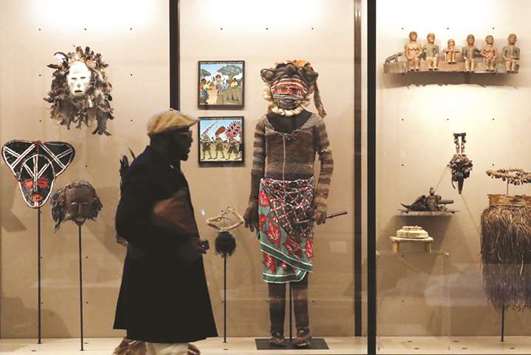Treasures looted from the continent have been repackaged in the hope of contributing to a more healthy debate about Belgium’s brutal past and multicultural future.
But there is an elephant in the room — and not just the giant taxidermic pachyderm looming over visitors to the remodelled Landscapes and Biodiversity gallery.
The former Royal Museum for Central Africa reopens in the Tervuren Palace outside Brussels amid a renewed European debate about returning stolen artefacts.
The museum’s research team insists the exhibits will now take a much more critical approach to the depredations of King Leopold II and his agents in Congo.
But should Belgium still be holding its African prizes at all and can it better integrate its growing African minority without first coming to terms with its past?
Several former imperial powers are confronting the issue, and last month French President Emmanuel Macron admitted that in principle Africa’s treasures should return.
But Belgium stands out from its neighbours, in part because institutions like the Tervuren Museum have been relatively slow to adapt to the post-colonial era.
“The permanent exhibition had barely changed since 1958, two years before Congo became independent,” says the collection’s curator and anthropologist Bambi Ceuppens.
Before it closed for refurbishment in 2013, visitors were greeted by a statue uncritically depicting white European missionaries “bringing civilisation to Congo.” But now, in Ceuppens’ words, the permanent collection is no longer “an exhibition of dead objects in an Africa without history and without human beings.”
Instead, with the help of multimedia displays and detailed captions, visitors will be encouraged to take a critical view and to see colonialism through African eyes.
The museum’s academic experts say there is no attempt to cover up the past, but rather to use the collection of 125,000 ethnographic objects more educationally.
You can still see a witch doctor in a leopard-skin cowl that resembles the villain in another notorious Belgian colonial artefact, the comic book “Tintin in the Congo”.
But the caricature is now in an underground side-gallery of statues arranged to demonstrate how colonialist art exploited and fetishised African subjects.
Above, however, main halls of the palace are lined with African objects that were in many cases plundered by military exhibitions or collected by curious missionaries.
The director of the museum and the research institute it houses, Guido Gryseels, says he respects calls for these items to be returned to their African homelands.
“I agree with President Macron when he says it’s not normal that 80% of African art objects are in Europe,” he told reporters this week.
“Obviously it’s their history, it’s their culture, it’s their identity. We’re willing to consider claims for restitution, but obviously there’s a lot more discussion to be done.”
The Belgian colonies, run as a private royal estate by Leopold II, covered lands now included in independent Rwanda, Burundi and the Democratic Republic of Congo.
These countries had a turbulent modern history and for European experts, in DR Congo’s case at least, lack premises to properly house a national history collection.
Activists plan to protest at the museum’s reopening, demanding a proper memorial to seven Congolese who died in 1897 after being brought to Belgium as living exhibits.
Paula Polanco said that her group, Intal-Congo, would come to their graves near the Tervuren estate to demand they be recognised as “victims of a colonialist crime.”
Meanwhile, DR Congo’s President Joseph Kabila has now said he plans to formally request the return of art and records before his country’s own museum opens next year.
The activists doubt the museum’s sincerity and have urged it, in Polanco’s words, to form a committee to “objectively and materially” determine the origin of the works.
So divisive is the debate that Belgium’s current king, Philippe, has declined an invitation to the weekend’s ceremony.
For Gryseels, the political backdrop is part of a broader Belgian conversation about race that goes beyond the rights and wrongs of the ownership of his museum’s exhibits.
“It’s not only our museum. It’s the overall Belgian society which is still very much a white society,” Gryseels said, insisting that everyone wants to see a more racially integrated future.
While France, Britain and the Netherlands, he said, saw large-scale arrivals from former colonies earlier, Belgium’s 250,000-strong African population came in the last 20 years.
And although the museum has been redesigned, statues and street names still honour Leopold, who personally enriched himself through the forced labour of the Congolese during a period in which an estimated half of the local population — up to 10mn people — were wiped out by overwork, violence and disease.
“Personally speaking, I think that indeed someone who is responsible for mass murder is not to be put literally upon a pedestal,” Ceuppens said.
Other statues should not be hidden, she argues, but used by the museum and educationalists as they explain Belgium and Congo’s intertwined histories.
And, by better understanding the past, Belgium may be better able to integrate Belgian-born Africans into a more diverse future.
“As recently as two months ago our prime minister gave a presentation here for all the top CEOs of Belgium and all the top ministers,” Gryseels said.
“And the whole audience here was full: 220 white people...Ten years from now the situation will be very different.”

